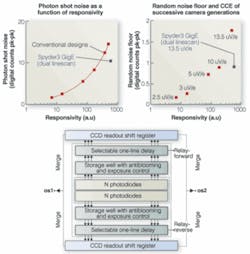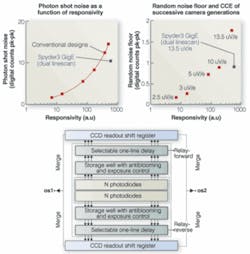Dual linescan imagers increase camera responsivity
Andrew Wilson, Editor, [email protected]
“More than most other types of machine-vision applications, linescan applications are starved for photons,” says Mark Butler, product manager at DALSA (Waterloo, ON, Canada; www.dalsa.com), “and, with line rates approximately 100--1000 times those of comparable frame rates of area-array camera, providing enough illumination to capture images from linescan-based cameras becomes expensive.”
Unfortunately, the trade-off between increased responsivity of cameras based around such devices is fewer signal electrons, which results in a higher photon shot noise relative to the camera’s output. “If these trends continue,” says Butler, “the camera’s read and photon shot noise will exceed the digital detection threshold of machine-vision applications.” Therefore, many companies are abandoning traditional linescan technology for cameras based on time-delay-integration (TDI) architectures.
While TDI-based cameras can increase the responsivity of the signal output from the camera, in many cases they are more difficult to set up and maintain than cameras based around single linescan devices. With this in mind, DALSA and Basler (Ahrensburg, Germany; www.baslerweb.com) have developed cameras around what both companies are calling dual-linescan architecture.
“To break the shot-noise-vs.-responsivity and read-noise-vs.-responsivity barrier common in single linescan architectures,” says Butler, dual linescan architectures contain two arrays of pixels (see figure on p. 10). In the design patented by DALSA, each array is connected to a selectable delay that either allows charge through or delays the charges by one scan line. The signal from these two arrays-one of which is delayed-are combined into a single output, effectively doubling the responsivity of the device.
“Not only does this double the responsivity in light-starved applications,” says Butler, “it also results in a twofold increase in the dynamic range of the device.” Better still, shot noise is decreased by a factor of the square root of two. DALSA’s dual linescan imager uses the company’s own CCD design in its 1k- and 2k-based Spyder3 GigE cameras, and Basler’s Sprint family is based on recently developed 2k and 4k CMOS imagers.
“The increasing demand for speed and throughput means that finding ways to improve responsivity is becoming more important,” says Lars Hansen, a product manager for the Vision Components division of Basler. “Basler now has exclusive rights to a next-generation linescan sensor that combines speed and sensitivity.” One novel feature of the imager is that the sensor’s maximum allowed line rate increases linearly as the area of interest is decreased, an advantage not possible with CCD sensors.
While DALSA’s offering runs at a 36-kHz line rate at 2k resolution, the CMOS-based Sprint series runs at 140 kHz with 4k resolution, nearly four times faster at double resolution. At VISION 2006 in Stuttgart, Germany, both companies demonstrated the effects of using dual linescan devices in these cameras.
The Stuttgart show was the first time that the Basler Sprint series camera was presented in a live demonstration running at a line rate of 70 kHz with 4k resolution. Hansen expects series production of the Sprint to start in the second quarter of this year.
“While such dual-linescan devices are useful in increasing the sensitivity of linescan cameras, they do have certain shortcomings,” says Butler. By using dual linescan sensors, dark current is increased by a factor of two. “But in many applications,” says Butler, “this is not important since the faster the device is clocked, the lower the dark current level.”
Both DALSA and Basler currently offer monochrome versions of their cameras; however, the concept of dual linescan architectures could be extended to color using two striped RGB devices. This has not been overlooked by Butler and his colleagues at DALSA. “While many of our customers require more accurate cameras based around trilinear devices,” says Butler, “striped RGB imagers can nonetheless provide a viable solution for many less-demanding applications.”
Hansen points out that color variants of the Sprint series will use a Bayer pattern. Since a standard image-data output protocol will be used, most existing frame grabbers will be compatible, and, because there is no gap between the two lines in the Sprint sensor, the spatial correction necessary with cameras based on a trilinear sensors do not need to be performed.

